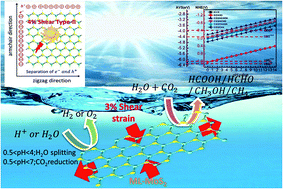Strain and pH facilitated artificial photosynthesis in monolayer MoS2 nanosheets†
Abstract
Photoconversion of carbon dioxide with water into renewable solar fuels using a single integrated system is the primary goal of artificial photosynthesis. The ease of applying mechanical strain reversibly in low dimensional materials can be exploited in optimizing their artificial photosynthetic or photocatalytic properties. In this work, strain effects on the concerted interplay of all the factors controlling the photocatalytic ability, such as suitable band edges straddling the redox potentials for CO2 reduction with the water and oxygen evolution reactions, optical absorbance and conductivity, carrier mobilities, carrier mobility ratios (i.e. hole/electron or electron/hole mobility ratio) and exciton binding energies, have been comprehensively studied on monolayer MoS2 nanosheets and calibrated, using density functional theory, to ascertain the type and magnitude of strain under which the optical absorbance and conductivity, carrier mobilities and the carrier mobility ratio are simultaneously and optimally enhanced, while the requisite redox reactivity and small exciton binding energies are retained. Additionally, the role of pH has been carefully addressed. Optical conductivity in pristine ML-MoS2 calculated in this work agrees with the experimental ones. Of all strain types studied, shear strain is found to be most effective in driving the kinetics of the light-driven reduction of CO2 with water, water reduction in the absence of CO2 [i.e. the H2 evolution reaction (HER)] and oxidation of water [i.e., the O2 evolution reaction (OER)] with nearly the same efficiency. The optical absorbance and conductivity are found to reach their maximum magnitude at 3% shear strain along the direction of lattice dilation. 0.5–3.5 and 0.5–6.5 ranges in pH are found to be favorable for the photo-catalytic HER and CO2 reduction with water respectively. Carrier mobility has been calculated using a more reliable and robust formulation where the carrier mobility depends not only on the carrier effective mass, deformation potential and elastic modulus along the longitudinal charge transport direction but also on these parameters along the transverse direction. Shear strain induces the maximum enhancement in carrier mobilities and the carrier mobility ratio, which facilitates the separation and migration of e−–h+ pairs along opposite or transverse directions and thereby in prolonging the carrier lifetimes, i.e., lowering their recombination rates.



 Please wait while we load your content...
Please wait while we load your content...